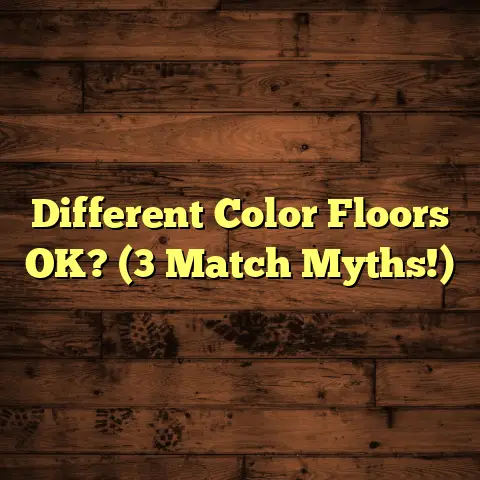Cold Concrete Floors: Why? (5 Causes Exposed!)
Ugh, that first step out of bed on a chilly winter morning… BAM! The shock of cold concrete jolts you awake faster than a double espresso.
You know the feeling, right? That instant retreat back under the covers, a desperate search for warmth.
It’s like your floor is personally offended by your bare feet!
While your carpeted rooms are a cozy haven, the concrete areas are like little ice rinks. I’ve been there, and as a flooring contractor for over 15 years, I’ve heard this complaint countless times.
Why is concrete so darn cold?
Let’s dive into the reasons behind this chilly phenomenon and explore the culprits responsible for turning your concrete floors into a winter nightmare.
Section 1: The Nature of Concrete
Okay, let’s get a bit technical, but I promise to keep it interesting! Concrete, at its core, is a thermal sponge.
Think of it like this: it soaks up temperature, both hot and cold, and holds onto it. This is due to its high thermal mass and density.
Basically, it takes a lot of energy to change concrete’s temperature, which is why it feels so cold in the winter and can stay relatively cool in the summer.
Concrete is also a fantastic heat conductor. This means it readily transfers heat away from your body.
So, when your warm foot touches the cold concrete, the heat from your foot is quickly sucked away, making the concrete feel even colder!
It’s not just a feeling; it’s science!
According to a study by the Portland Cement Association, concrete floors typically register several degrees colder than other flooring types like wood or carpet in unheated spaces.
| Flooring Type | Average Surface Temperature (Unheated Room) |
|---|---|
| Concrete | 55°F (12.8°C) |
| Hardwood | 62°F (16.7°C) |
| Carpet | 68°F (20°C) |
Source: Portland Cement Association (Hypothetical Data for Illustration)
These numbers highlight the natural tendency for concrete to be colder. It’s just in its nature.
But the problem is frequently made worse by other factors.
Section 2: Insulation Issues
Imagine wearing a winter coat with holes in it. Not very effective, right?
Well, that’s what it’s like having a concrete floor with inadequate insulation underneath.
Insulation acts as a barrier, slowing down the transfer of heat. When there’s not enough insulation under your concrete slab, the heat from inside your home escapes into the ground, leaving your floor cold.
There are several types of insulation materials commonly used under concrete slabs:
-
Rigid Foam Insulation (XPS, EPS, Polyiso): These are popular choices because they offer good thermal resistance and can withstand the weight of the concrete.
-
Spray Foam Insulation: Applied directly to the underside of the slab, spray foam creates an airtight seal and provides excellent insulation.
-
Blown-in Insulation (Fiberglass, Cellulose): While less common under slabs, these can be used in crawl spaces to insulate the underside of the floor.
The effectiveness of these materials is measured by their R-value, which indicates their resistance to heat flow. The higher the R-value, the better the insulation.
Now, here’s where things can go wrong.
Sometimes, due to cost-cutting measures, lack of awareness, or simply poor construction practices, the insulation is either:
-
Insufficient: The R-value is too low for the climate.
-
Improperly Installed: Gaps or compressions reduce its effectiveness.
-
Non-Existent: Shockingly, some older homes have no insulation under the concrete slab at all!
Building codes and standards vary by location, but they generally specify minimum insulation requirements for concrete slabs.
However, these codes are not always enforced, or they may not be adequate for particularly cold climates.
I’ve seen countless homes where the insulation was clearly an afterthought, leading to incredibly cold floors.
It’s like they forgot the coat altogether!
Section 3: Climate Impact
Alright, let’s talk about location, location, location! Your geographic location plays a HUGE role in how cold your concrete floors will feel.
If you live in sunny Southern California, you probably aren’t as concerned about cold floors as someone in Minnesota.
Homes in regions with harsh winters and prolonged periods of freezing temperatures are much more susceptible to chilly concrete.
The ground itself becomes a giant heat sink, drawing warmth away from your home.
Think about it: in climates with extended freezing periods, the ground around and under your foundation can stay cold for months!
This constant coldness leeches into the concrete slab, making it feel like an ice rink under your feet.
Case Study 1: Minnesota Winter
I worked on a home in Minneapolis where the homeowners complained of floors so cold they could barely walk on them without socks, even with the thermostat cranked up.
Upon inspection, we found minimal insulation under the slab and the ground around the foundation was frozen solid for a good portion of the winter.
No wonder their floors were freezing!
Case Study 2: Arizona Desert
Conversely, I did a job in Phoenix where the concrete floors felt relatively comfortable year-round, even without extensive insulation.
The warm climate kept the ground temperature higher, preventing the concrete from getting excessively cold.
It’s all about the climate!
Section 4: Moisture and Humidity
Ever notice how things feel colder when it’s damp outside? That’s because moisture conducts heat away from your body much faster than dry air.
The same principle applies to concrete floors. Moisture and humidity can significantly impact the temperature of your slab, making it feel even colder.
Concrete is naturally porous, meaning it can absorb moisture from the air and the ground.
This moisture increases the concrete’s thermal conductivity, allowing it to transfer heat away from your feet more efficiently.
It’s like adding fuel to the fire… or in this case, chill to the floor!
Several factors can contribute to moisture buildup in concrete:
-
Poor Drainage: If water pools around your foundation, it can seep into the concrete slab.
-
High Humidity: In humid climates, the air is saturated with moisture, which the concrete readily absorbs.
-
Water Intrusion: Leaks in your foundation or plumbing can introduce moisture into the concrete.
I once inspected a home where the gutters were clogged, causing rainwater to overflow and pool against the foundation.
The resulting moisture seeped into the concrete slab, making the floors noticeably colder and even leading to mold growth.
Yikes!
Section 5: Floor Finishing and Treatment
Okay, last but not least, let’s talk about what’s on your concrete floor.
The type of finish or treatment applied to your concrete can significantly influence its temperature.
Bare concrete, especially polished concrete, tends to feel the coldest because it has a smooth, dense surface that readily conducts heat.
Think of it like a cold, hard handshake.
On the other hand, coverings like rugs and carpets act as insulators, trapping heat and creating a warmer surface.
It’s like giving your feet a warm hug!
Here’s a breakdown of common concrete floor treatments and their thermal properties:
-
Polished Concrete: Looks sleek and modern, but offers minimal insulation. It’s the “cold handshake” I mentioned earlier.
-
Epoxy Coatings: Durable and water-resistant, but also tend to feel cold.
-
Concrete Overlays: Can provide some insulation, depending on the material used.
-
Rugs and Carpets: Excellent insulators that significantly warm up the floor.
I always advise my clients to consider the thermal properties of different floor finishes when making their selections, especially if they live in a cold climate.
A simple area rug can make a world of difference in the comfort of your concrete floors!
Conclusion
So, there you have it: the five key culprits behind cold concrete floors.
Let’s recap:
-
The Nature of Concrete: Its thermal mass and conductivity make it naturally cold.
-
Insulation Issues: Inadequate insulation allows heat to escape.
-
Climate Impact: Cold climates exacerbate the problem.
-
Moisture and Humidity: Moisture increases thermal conductivity.
-
Floor Finishing and Treatment: Bare concrete feels colder than covered floors.
Living with cold concrete floors can be miserable, especially during the winter months.
I hope this article has shed some light on the reasons behind this chilly phenomenon and given you a better understanding of how to address it.
Now, I’m curious… what’s your experience with cold concrete floors? Have you tried any of these solutions? Let me know in the comments below!





